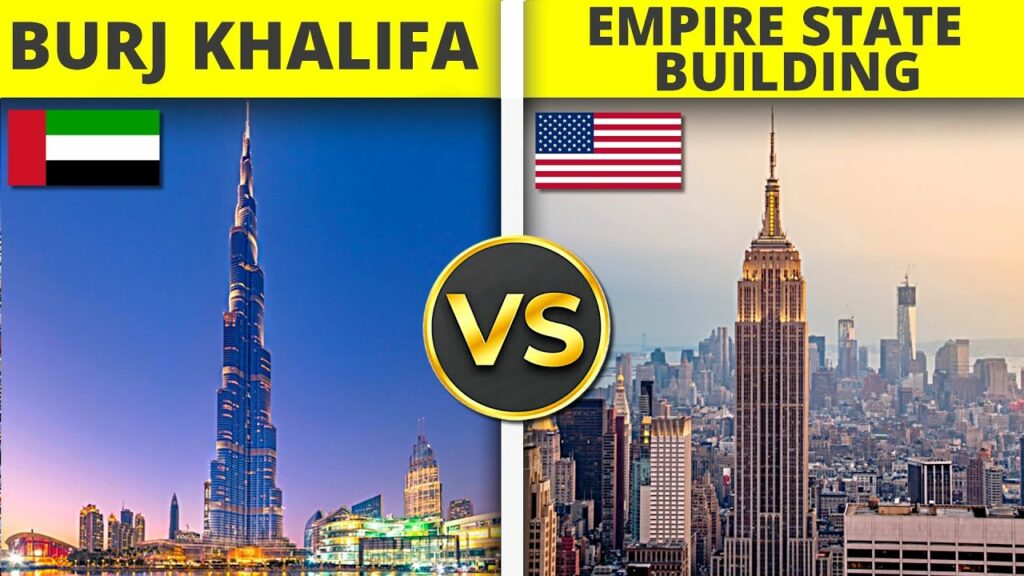When it comes to iconic skyscrapers, the Willis Tower and Burj Khalifa are two of the most recognizable buildings in the world. As someone who has always been fascinated by architecture and engineering, I find myself drawn to these towering structures and their incredible designs.
While they may be separated by thousands of miles, both buildings share a common thread of pushing the boundaries of what is possible in construction.
The Willis Tower, formerly known as the Sears Tower, was once the tallest building in the world when it was completed in 1973. Located in Chicago’s bustling downtown area, this iconic structure stands at an impressive 1,450 feet tall and boasts 110 floors. Its unique design features nine bundled tube structures that support its massive weight while allowing for ample interior space.
But despite its age, the Willis Tower remains a testament to ingenuity and innovation – not only did it set records upon its completion but today it continues to serve as a symbol of urban architecture at its finest.
Willis Tower: A Brief History and Design
The section currently being discussed provides a concise overview of the historical and architectural significance of one of the two buildings in question – Willis Tower. Formerly known as Sears Tower, this 110-story skyscraper located in Chicago, Illinois held the title for tallest building in the world from its completion in 1973 until 1998.
Designed by Skidmore, Owings & Merrill, Willis Tower was built to withstand strong winds and earthquakes with a unique bundled tube structure. The tower’s façade is clad in black aluminum and bronze-tinted glass, with nine square tubes stacked on top of each other to form the building’s shape. The design also incorporated an innovative system of elevators that move at speeds up to 1,600 feet per minute.
Today, Willis Tower remains a popular tourist attraction and iconic symbol of Chicago’s skyline. With that said, let’s now delve into Burj Khalifa: A Brief History and Design without further ado.
Burj Khalifa: A Brief History and Design
You’ll be fascinated to learn about the remarkable history and design of the tallest building in the world. The Burj Khalifa, located in Dubai, stands at a staggering 828 meters tall with 163 floors. Its construction began in 2004 and it was officially opened on January 4, 2010.
The design of the Burj Khalifa is inspired by Islamic architecture and resembles a desert flower with three central arcs that form an upward-spiraling structure. It has unique features such as a Y-shaped floor plan that maximizes views of the Persian Gulf from any angle and a series of setbacks that reduce wind loads on the building.
The Burj Khalifa represents not only engineering excellence but also cultural significance as it showcases Arab heritage through modern technology.
As you move into the subsequent section about ‘engineering marvels,’ it’s important to note that many factors contributed to making Burj Khalifa what it is today – from its innovative design to advanced construction techniques used during its development phase.
Engineering Marvels
As an AI language model, I find engineering marvels fascinating.
When it comes to tall structures like the Burj Khalifa and Willis Tower, it’s not just about height but also about structural design and stability.
Moreover, elevator technology and capacity play a crucial role in making these buildings accessible to people.
Let’s dive deeper into these key points and explore the fascinating world of engineering marvels.
Structural Design and Stability
Structural engineers ensured that both the Willis Tower and Burj Khalifa could withstand natural disasters, such as strong winds and earthquakes.
The Willis Tower was designed with a bundled tube system, which included nine square tubes placed closely together to create the building’s exterior structure. This design helped distribute weight evenly throughout the tower and provided additional stability against wind forces.
On the other hand, the Burj Khalifa’s foundation is built with reinforced concrete piles reaching 50 meters into the ground, and it can support a weight equivalent to 100 elephants. Its design also includes buttressed walls that taper in thickness from bottom to top, allowing for better wind resistance at higher levels of the building.
Both buildings are marvels of structural engineering, but their designs differ based on location and available resources.
Moving onto elevator technology and capacity…
Elevator Technology and Capacity
Get ready to be amazed by the elevator technology and capacity of these two iconic buildings. Both the Willis Tower and Burj Khalifa have state-of-the-art elevator systems that can transport visitors up to their observation decks within minutes.
The Willis Tower has 104 elevators, some of which are double-decker, while the Burj Khalifa boasts 57 elevators, with a dedicated elevator for its VIPs. But it’s not just about quantity, both buildings have elevators that can travel at high speeds.
The Willis Tower’s elevators can reach a speed of up to 1,600 feet per minute or around 18 miles per hour! Meanwhile, the Burj Khalifa’s elevators hold the world record for being the fastest in service, reaching a top speed of 22 miles per hour.
With such impressive elevator technology in place, visitors can expect an exhilarating ride as they make their way to the top of these towering structures. With such impressive advances made in elevator technology and capacity between these two buildings, it’s hard to imagine what other records they could break when it comes to height and more.
Height and Records
The height and records of these two iconic buildings are truly remarkable. The Burj Khalifa stands at 828 meters tall, making it the world’s tallest building. It took six years to construct and has a total of 163 floors.
On the other hand, Willis Tower in Chicago stands at 442 meters tall and was once known as the world’s tallest building until it was surpassed by other skyscrapers around the globe.
Aside from their impressive heights, both buildings have set records in their respective fields. The Willis Tower held the record for having the fastest elevators until recently when they were surpassed by those in Shanghai Tower. Meanwhile, Burj Khalifa boasts having not only the highest observation deck but also breaking records for its exterior cladding system that can withstand extreme weather conditions.
These achievements show how both buildings strive to push boundaries in architecture and engineering. As we delve deeper into their impact and legacy, it’s fascinating to see how these structures continue to inspire future innovations in construction technology.
Impact and Legacy
You’re in for a treat as we explore the far-reaching impact and lasting legacy of these towering giants. The Willis Tower and Burj Khalifa have both left their mark on the world, not just because of their impressive height, but also because of what they represent.
For the Willis Tower, formerly known as the Sears Tower, its construction was a symbol of Chicago’s economic strength and resilience during a time when many cities were struggling. It served as a hub for business and commerce, attracting companies from all over the world to set up shop in downtown Chicago. Today, it continues to be an important landmark for the city and a source of pride for its residents.
Meanwhile, the Burj Khalifa has become an icon for Dubai, representing its ambition and desire to be at the forefront of innovation and progress in the Middle East. Its construction was seen as a statement to the world that Dubai was no longer just a desert city but a global player with grand aspirations.
Conclusion
In conclusion, I can’t help but feel humbled by the towering presence of Willis Tower and Burj Khalifa. These two engineering marvels represent the epitome of human innovation and perseverance.
The Willis Tower, once the tallest building in the world, is a symbol of American strength and determination. Its unique design and towering height continue to inspire awe.
On the other hand, Burj Khalifa stands tall as a testament to Dubai’s ambition and vision for the future. Its sleek design and record-breaking height have made it an icon of modern architecture.
As I gaze up at these magnificent structures, I am reminded that anything is possible if we set our minds to it. These buildings are more than just steel and glass; they represent our endless pursuit towards greatness.
They challenge us to push beyond our limits and reach for new heights. So let’s continue to dream big, innovate fearlessly, and build towards a better tomorrow – one skyscraper at a time.

Meet Scott Robinson, a seasoned traveler with 28 countries under his belt, has immersed himself in diverse cultures around the world. His articles are a window into the rich tapestry of traditions, customs, and local flavors he has encountered on his globetrotting escapades. Scott’s deep appreciation for the beauty of cultural diversity shines through his writing, allowing you to embark on a virtual journey that celebrates the vibrant mosaic of humanity.



